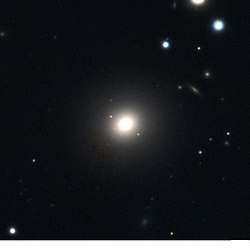NGC 687
NGC 687 is a lenticular galaxy located 220 million light-years away[2] in the constellation Andromeda. It was discovered by astronomer William Herschel on September 21, 1786[3] and is a member of Abell 262.[4][5][6][7]
| NGC 687 | |
|---|---|
 Pan-STARRS image of NGC 687. | |
| Observation data (J2000 epoch) | |
| Constellation | Andromeda |
| Right ascension | 01h 50m 33.2s[1] |
| Declination | 36° 22′ 15″[1] |
| Redshift | 0.016982[1] |
| Helio radial velocity | 5091 km/s[1] |
| Distance | 220 Mly (66 Mpc)[1] |
| Group or cluster | Abell 262 |
| Apparent magnitude (V) | 13.30[1] |
| Characteristics | |
| Type | S0[1] |
| Size | ~110,000 ly (33.6 kpc) (estimated)[1] |
| Apparent size (V) | 1.4 x 1.4[1] |
| Other designations | |
| CGCG 522-17, MCG 6-5-14, PGC 6782, UGC 1298[1] | |
See also
References
- "NASA/IPAC Extragalactic Database". Results for NGC 687. Retrieved 2018-11-18.
- "Your NED Search Results". ned.ipac.caltech.edu. Retrieved 2018-11-19.
- "New General Catalog Objects: NGC 650 - 699". cseligman.com. Retrieved 2018-11-14.
- M., Garcia, A. (July 1993). "General study of group membership. II - Determination of nearby groups". Astronomy and Astrophysics Supplement Series. 100: 47. Bibcode:1993A&AS..100...47G. ISSN 0365-0138.
- Giuricin, Giuliano; Marinoni, Christian; Ceriani, Lorenzo; Pisani, Armando (November 2000). "Nearby Optical Galaxies: Selection of the Sample and Identification of Groups". The Astrophysical Journal. 543 (1): 178–194. arXiv:astro-ph/0001140. Bibcode:2000ApJ...543..178G. doi:10.1086/317070. ISSN 0004-637X.
- "Detailed Object Classifications". ned.ipac.caltech.edu. Retrieved 2018-11-19.
- "NGC 687". Retrieved 2018-11-20.
External links
- NGC 687 on WikiSky: DSS2, SDSS, GALEX, IRAS, Hydrogen α, X-Ray, Astrophoto, Sky Map, Articles and images
This article is issued from Wikipedia. The text is licensed under Creative Commons - Attribution - Sharealike. Additional terms may apply for the media files.